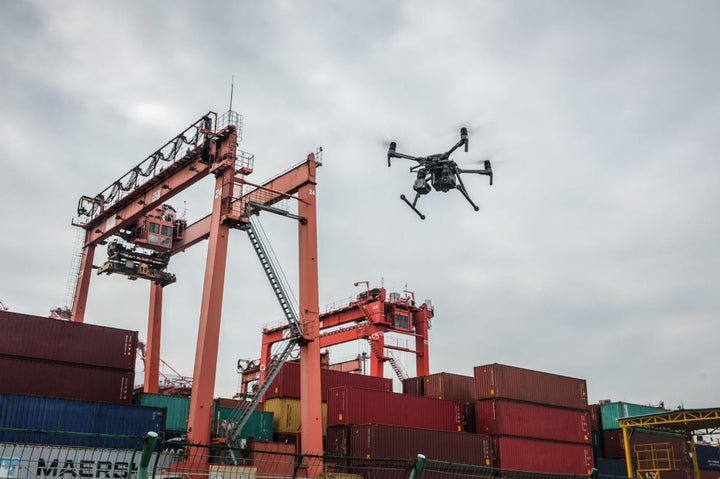DJI is one of the most popular brands when it comes to drone technology. It’s a top drone brand that produces high-quality drones — like the Phantom 4 Pro. As part of DJI’s Phantom series of products, the Phantom 4 Pro is one of the best products they have. Unfortunately, it’s still frequently overlooked by many drone enthusiasts.
If you’re looking for a new drone, it’s a great option to consider. To help you understand why, this article discusses all the basics you need to know about the DJI Phantom 4 Pro. Moreover, explore its amazing specs and features. You’ll also learn how to fly and maintain it to ensure you can use it for a long time.
Key Specs and Features Highlights


The Phantom 4 Pro is an advanced consumer and entry-level professional drone. It has many improved qualities compared to the previous P4 model in terms of the following:
- Camera: 1-inch sensor, 20MP, 4K/60fps video @ 100Mbps
- Flight Time: 30 minutes
- Live View Quality: 720P @ 30fps
- Weight: 1388 grams
Additionally, it offers several advanced key features, including:
Intelligent Flight Modes

There are three different modes you can choose your drone to fly in:
P-Mode (Position)
This is the drone's regular and default flight mode, which includes GPS and GLONASS satellite positioning. The P-mode would allow you to use obstacle sensing and visual positioning. It’s also the required mode, so you can use the three automatic flight modes:
- TapFly: You tap the screen to point your drone in a certain direction.
- Draw: You can draw the route on the screen, and the drone will follow it.
- Return to Home: This will set your drone to return safely to your base by following the safe path it took.
S-Mode (Sport)
This is the mode if you want a faster flight. The S-mode allows you to fly the drone at speeds of up to 45 mph. When switched to this mode, you’ll have full satellite and vision positioning support.
A-Mode (Attitude)
This is for the experts or experienced pilots because this mode switches off the GPS. However, the altitude is kept, allowing users to fly steadily and smoothly.
ActiveTrack on Subjects
This feature allows you to mark and track a specific moving object. For solo operators, this makes taking quality videos and photos easier. You can lock on a subject, and the drone will track it, adjusting speeds accordingly. It also has three modes:
- Trace: The drone will follow the subject, either behind it or in front of it.
- Profile: The drone will fly and follow the subject alongside it.
- Spotlight: The drone will mark, recognize, and keep the subject in frame while you fly the drone in any direction.
Obstacle Sensing and Avoidance
The Phantom 4 Pro has high-resolution stereo vision sensors that give it a 5-direction of obstacle sensing ability. It has one at the rear, a pair at the front, and one infrared sensing system on its left and right. This also gives the drone a 4-direction of obstacle avoidance, making flights safer.
Remote Controller
It has a remote controller, a 5.5-inch high luminance monitor, and a 5-hour battery life. This is integrated with the DJI GO app to control your drone fully. The built-in screen has great brightness, and since the DJI GO is built into it, you can edit and share your captures instantly.
Tutorial: Basic Flight Maneuvers
First of all, you have to know that there are two control or operating modes in the remote controller. In Mode 1, the right stick will serve as your throttle control. But in Mode 2, the left one will. Use the left one for common practice, as many advanced tutorials commonly use this as the throttle.
If you’re a new DJI drone user or a complete drone beginner, here’s an essential guide for a basic drone flight experience:
Take-Off
Using the remote controller, make the drone take off. Start by pushing the left stick up to ascend from its landing position. If you want to hover, push both sticks towards the center. It’s best not to push too much since this can affect the speed of the movements.
Rotating
Using the left stick again, you can move it to the left or right to control the rotation of the drone. Push it to the left to rotate it counterclockwise. Push it to the right to rotate clockwise. To maintain the drone’s orientation, center the stick.
Moving in Certain Directions
The right stick on the controller serves as your control hub for adjusting the pitch and roll of the drone. To move the drone forward or backward, simply move the right stick up and down. Push it upward to move the drone forward and downward to fly backward.
Likewise, to make the drone fly to the left or right, you make use of the right stick again. Push the stick to the left to fly left, and push it to the right to fly in the right direction.
Landing
To land, simply push the left stick downwards. However, ensure that you land the drone in a safe area with no people or obstacles.
Proper Maintenance Practices for Your Drone Batteries

Remember that you’ll only be able to fly your drone when its battery is well and fully charged. This is why you must take care of the DJI lithium-ion batteries that come with the drone.
Since it’s a different kind of battery, here are some tips and practices you can follow to keep your batteries safe and healthy:
- Check and Follow the User Manual
Drone packages come with complete and useful manuals. This is the best source of information for battery safety guides in terms of usage, maintenance, charging, storage, and disposal. Before anything, check and follow the instructions there first.
- Beware of Extreme Temperatures
Extreme temperatures are bad for the battery. Don’t use, charge, or store your drone batteries in temperatures beyond their recommended ranges. For the Phantom 4 Pro batteries, charging and operating temperatures should be at most 104°F.
- Charge Responsibly
DJI batteries are specifically designed to work with DJI chargers. That’s why it’s crucial to use an official DJI charger when charging your batteries. Non-DJI chargers might damage the batteries.
- Don’t Store at 100%
Never charge your batteries to 100% before storing them. The DJI batteries will automatically discharge to protect the integrity of their cells. When a battery is at 100%, the cells inside it get stressed, which, if it continues, can decrease its operational life cycle and capacity. For optimal storage conditions, make sure the battery is at 60%.
Get Ready to Fly With DJI Phantom 4 Pro
Whether you have experience flying a drone or are a total beginner, DJI offers the best products in the market. One of their best ones is the DJI Phantom 4 Pro. It has high-resolution cameras you can use to capture fantastic images and videos. It also has intelligent features like flight modes and obstacle sensing and avoidance. For a high-quality drone like this, it surely is worth it!
If you want to look at the actual Phantom 4 Pro or other drones, you can check out our drone collection. We offer many high-quality drones from DJI and other top brands for different levels of experience and needs.


